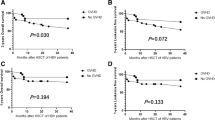Abstract
The purposes of this study were to evaluate the infection by hepatitis B virus (HBV) and its impact on survival and to provide a clinical reference for monitoring and treating HBV during and after autologous hematopoietic stem cell transplantation (ASCT) in patients with multiple myeloma (MM). A retrospective analysis of HBV infections was performed in 70 MM patients who received a sequential bortezomib-containing induction therapy and ASCT in our department from June 2006 to February 2012. Among the 70 patients in our study, 11 cases (15.7 %) were hepatitis B surface antigen positive (HBsAg+), and 23 cases (33.3 %) were hepatitis B core antibody positive (HBcAb+). Eight cases were HBsAg, hepatitis B e antibody (HBeAb), and HBcAb positive, while one case was HBsAg, hepatitis B e antigen (HBeAg), and HBcAb positive. The median follow-up times for the HBsAg+ group and the HBsAg-negative (HBsAg−) group were 27.0 (7.6–85.2) months and 28.7 (7.1–111.0) months, respectively. The 1-year, 2-year, and 3-year overall survival rates of the HBsAg+ group were 90.9, 80.8, and 34.6 %, respectively, and the median survival time was 31.2 months (95 % CI, 24.8–37.6). The 1-year, 2-year, and 3-year overall survival rates of the HBsAg− group were 98.2, 94, and 84.6 %, respectively, while the median survival time was not yet available. There was a statistically significant difference (p = 0.008) in the overall survival rate between the two groups. By Cox regression analysis, we found that the HBsAg+ status was a prognostic factor, which could independently influence the overall survival rate for ASCT. In conclusion, the HBsAg+ status is an independent risk factor for patients with MM receiving ASCT. The application of standard antiviral treatment might help to overcome this risk factor.

Similar content being viewed by others
References
Shitani M, Sasaki S, Akutsu N, Takagi H, Suzuki H, Nojima M, et al. Genome-wide analysis of DNA methylation identifies novel cancer-related genes in hepatocellular carcinoma. Tumour Biol. 2012;33(5):1307–17.
Pinato DJ, Rossi D, Minh MT, Toniutto P, Boccato E, Minisini R, et al. Hepatitis B virus and lymphomagenesis: novel insights into an occult relationship. Dig Liver Dis. 2012;44(3):235–8.
Huang B, Li J, Zhou Z, Zheng D, Liu J, Chen M. High prevalence of hepatitis B virus infection in multiple myeloma. Leuk Lymphoma. 2012;53(2):270–4.
San Miguel JF, Schlag R, Khuageva NK, Dimopoulos MA, Shpilberg O, Kropff M, et al. Persistent overall survival benefit and no increased risk of second malignancies with bortezomib–melphalan–prednisone versus melphalan–prednisone in patients with previously untreated multiple myeloma. J Clin Oncol. 2013;31(4):448–55.
Koehne G, Giralt S. Allogeneic hematopoietic stem cell transplantation for multiple myeloma: curative but not the standard of care. Curr Opin Oncol. 2012;24(6):720–6.
Ma SY, Au WY, Ng IO, Lie AK, Leung AY, Liang RH, et al. Role of liver biopsy in the management of liver dysfunction after hematopoietic stem-cell transplantation in a hepatitis B virus-prevalent patient population. Transplantation. 2003;76(1):169–76.
Uhm JE, Kim K, Lim TK, Park BB, Park S, Hong YS, et al. Changes in serologic markers of hepatitis B following autologous hematopoietic stem cell transplantation. Biol Blood Marrow Transplant. 2007;13(4):463–8.
Hui CK, Lie A, Au WY, Leung YH, Ma SY, Cheung WW, et al. A long-term follow-up study on hepatitis B surface antigen-positive patients undergoing allogeneic hematopoietic stem cell transplantation. Blood. 2005;106(2):464–9.
Wan S, Civan J, Rossi S, Yang H. Profiling HBV integrations in hepatocellular carcinoma. Hepatobiliary Surg Nutr. 2013;2(2):124–6.
Yano Y, Seo Y, Azuma T, Hayashi Y. Hepatitis B virus and host factors. Hepatobiliary Surg Nutr. 2013;2(2):121–3.
Wang F, Xu RH, Han B, Shi YX, Luo HY, Jiang WQ, et al. High incidence of hepatitis B virus infection in B-cell subtype non-Hodgkin lymphoma compared with other cancers. Cancer. 2007;109(7):1360–4.
Che L, Yuan YH, Jia J, Ren J. Activation of sonic hedgehog signaling pathway is an independent potential prognosis predictor in human hepatocellular carcinoma patients. Chin J Cancer Res. 2012;24(4):323–31.
Byam J, Renz J, Millis JM. Liver transplantation for hepatocellular carcinoma. Hepatobiliary Surg Nutr. 2013;2(1):22–30.
Jiang X, Pan S, Groh M, Liu S, Morrison H. Increasing incidence in liver cancer in Canada, 1972–2006: age-period–cohort analysis. J Gastrointest Oncol. 2011;2(4):223–31.
Yeo W, Chan PK, Zhong S, Ho WM, Steinberg JL, Tam JS, et al. Frequency of hepatitis B virus reactivation in cancer patients undergoing cytotoxic chemotherapy: a prospective study of 626 patients with identification of risk factors. J Med Virol. 2000;62(3):299–307.
Lee KH, Wu CJ, Wang CC, Hung JH. Prevention of chronic HBV infection induced hepatocellular carcinoma development by using antiplatelet drugs. Hepatobiliary Surg Nutr. 2012;1(1):57–8.
Conflicts of interest
None
Author information
Authors and Affiliations
Corresponding author
Additional information
Juan Li and Junru Liu contributed equally in this study.
Rights and permissions
About this article
Cite this article
Li, J., Liu, J., Huang, B. et al. Hepatitis B virus infection status is an independent risk factor for multiple myeloma patients after autologous hematopoietic stem cell transplantation. Tumor Biol. 34, 1723–1728 (2013). https://doi.org/10.1007/s13277-013-0709-z
Received:
Accepted:
Published:
Issue Date:
DOI: https://doi.org/10.1007/s13277-013-0709-z




